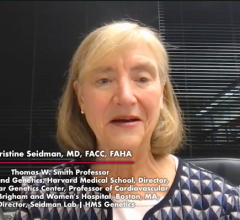
April 20, 2016 — Lowering cholesterol with statins significantly reduced adverse cardiovascular events in people with average cholesterol and blood pressure levels who were considered to be at intermediate risk for heart disease, according to a new study. Concurrently, use of blood pressure-lowering medications was beneficial only in those with higher blood pressure levels, according to three separate reports from the large HOPE-3 trial presented at the American College of Cardiology’s 65 Annual Scientific Session, April 2-4 in Chicago.
Previous studies have focused on the impacts of cholesterol and blood pressure-lowering drugs for people with established cardiovascular or renal disease, diabetes, other high-risk conditions or in those with markedly elevated cholesterol or blood pressure levels. Current guidelines recommend the use of these drugs mainly in patients at high risk for cardiovascular disease.
The trial, called HOPE-3, is the first to assess outcomes of preventative treatment with cholesterol and blood pressure-lowering drugs in a large, globally diverse population at intermediate risk for developing cardiovascular disease. Statins, alone or in combination with blood pressure-lowering drugs, were found to be superior to placebo for both the study’s first co-primary endpoint — a composite of cardiovascular deaths, heart attacks and strokes — and its second co-primary endpoint — a composite of those events plus heart failure, resuscitated cardiac arrest and revascularization procedures, such as bypass surgery or angioplasty. For these endpoints, blood pressure drugs were found to improve outcomes compared with placebo only in patients with elevated blood pressure; these drugs were associated with no improvements in patients without elevated blood pressure, and there was a trend toward worse outcomes in those with relatively low blood pressure.
“The implications for practice are huge — I think we certainly should consider using statins much more widely than we have used them thus far,” said Salim Yusuf, M.B.B.S., D.Phil., professor of medicine at McMaster University, executive director of the Population Health Research Institute of McMaster University and Hamilton Health Sciences and a senior member of the research team. “In particular for patients with hypertension, our study suggests you can essentially double the benefit of lowering blood pressure in hypertensives if you also lower cholesterol simultaneously.”
The trial included 12,705 people in 21 countries on six continents. All participants had at least one known cardiovascular risk factor, such as smoking, an elevated waist-to-hip ratio or a family history of heart disease, but none had been diagnosed with cardiovascular disease. The trial was designed to focus on preventing cardiovascular disease before it starts.
Participants were randomly assigned to receive either a cholesterol-lowering drug (10 milligrams of rosuvastatin) or a placebo pill daily and either a blood pressure lowering drug (a combination pill with 16 milligrams of candesartan and 12.5 milligrams of hydrocholothiazide) or a placebo pill daily. Through this randomization, patients were sorted evenly into four categories: those receiving both a cholesterol-lowering drug and a blood pressure-lowering drug; those receiving only a cholesterol- lowering drug; those receiving only a blood pressure-lowering drug; and those receiving only placebo pills. Outcomes were tracked for a median of 5.6 years.
Cardiovascular death, heart attack or stroke occurred in 3.5 percent of patients receiving both drugs and in 5 percent of patients receiving only placebo. The relative risk reduction in those taking both drugs was 30 percent overall, 40 percent in those with elevated blood pressure and 20 percent in those without elevated blood pressure. The results for the study’s second co-primary endpoint were identical for this analysis.
A separate analysis focusing on the use of statins alone showed 3.7 percent of participants who took statins experienced the first co-primary endpoint, a significant reduction compared with 4.8 percent among patients taking a placebo. Among patients taking statins, 4.4 percent experienced the second co-primary endpoint, a significant reduction compared with 5.7 percent among patients taking a placebo. Patients taking statins experienced, on average, a drop in low-density lipoprotein (LDL) cholesterol of 39.6 mg/dL, about 25 percent, after 12 months.
The benefits of statins were similar across all ethnic groups and across all baseline LDL levels, suggesting that a person’s starting cholesterol levels are not important in determining whether the person will benefit from statins. These findings suggest that many people who have average cholesterol and blood pressure levels and are at average risk for heart disease — and not just those with extremely high cholesterol or blood pressure levels — can benefit from statins. The treatment was also remarkably safe; although some patients reported muscle weakness or pain, these effects were generally alleviated by stopping the statins or reducing the dose.
“The take-home message is that statins are safe and effective, and that because benefits were similar irrespective of pretreatment cholesterol levels or levels of inflammatory markers, no baseline blood tests are required to identify the patients who will derive benefits from this treatment,” said Jackie Bosch, Ph.D., associate professor of rehabilitation science at McMaster University and director of the prevention Program at the Population Health Research Institute, who led the report focused on rosuvastatin. “Our results were remarkably consistent across all subgroups.”
An analysis focusing on the use of blood pressure-lowering drugs alone revealed no significant improvements overall in those receiving the drugs compared with those receiving a placebo. However, in a pre-specified analysis, when the patients were stratified into thirds by baseline systolic blood pressure, an analysis of subgroups with the highest, middle and lowest starting systolic blood pressure revealed significant differences. Among the one-third of participants with the highest blood pressure (a starting systolic blood pressure above 143.5 mm Hg), 4.8 percent experienced the first co-primary endpoint and 5.7 percent experienced the second co-primary endpoint — significantly lower than 6.5 and 7.5 percent, respectively, among patients taking placebo.
“Overall in this population the blood pressure-lowering drugs had no clear benefit, but in those with higher blood pressure before therapy, the treatment was effective. However, there was no benefit in those with lower blood pressure and even a tendency towards harm in those in the lowest third of the blood pressure distribution,” said Eva Lonn, M.D., FACC, a cardiologist and professor of cardiology at McMaster University and senior scientist at the Population Health Research Institute. “These data suggest blood pressure-lowering medications are appropriate for people with hypertension but that people with lower blood pressure who have no other reasons to use blood pressure reducing drugs should avoid taking these drugs.”
Treating high blood pressure can be a time-consuming and intensive process involving multiple visits to the doctor’s office for blood tests to help adjust dosing. This itself has been a significant impediment to reducing risk in people with hypertension because many patients find it inconvenient to make multiple visits or use multiple drugs, especially at full doses, which carries a higher risk of side effects. Yusuf said the study findings point to the value of a more simplified approach, which places more emphasis on statins in the general population and adds low doses of combination blood pressure medications to the statins in patients with mild hypertension. In this study, combination therapy reduced risk among people with elevated blood pressure by 40 percent safely, without dose titration or the need for frequent blood tests.
“Most of the hypertension guidelines right now focus on what agents to use and what blood pressure to aim for, and there has been very little emphasis on the importance of statins in treating patients with hypertension,” Yusuf said. “Our approach, which used a combination of moderate doses of two blood pressure lowering-drugs plus a statin, appears to produce the biggest ‘bang,’ in terms of reducing events, with few side effects.”
One limitation of the study is that, while it tracked patients for more than five years — a long period of time compared to most clinical trials — it can take many more years or even decades to show the full improvements in outcomes from primary disease prevention interventions. It is possible that extending the study for a longer period of time may have revealed larger benefits.
Participants will be tracked for an additional three to five years. The researchers will continue to conduct additional analyses examining the effects on cognitive decline, erectile dysfunction and vision, along with detailed analyses of potential differences among ethnic groups and geographic regions.
The study was funded by the Canadian Institutes of Health Research and AstraZeneca, the manufacturer of the drugs tested. The study was independently designed and conducted by the Population Health Research Institute at McMaster University and Hamilton Health Sciences in Canada, which conducts epidemiologic studies and clinical trials in more than 50 countries.
Yusuf, Lonn and Bosch have received institutional research grants from several pharmaceutical companies, and Yusuf and Lonn have served as consultants for several pharmaceutical companies.
The results of the study will be simultaneously published in three reports online in the New England Journal of Medicine at the time of presentation.
For more information: www.nejm.org


 July 10, 2024
July 10, 2024 









